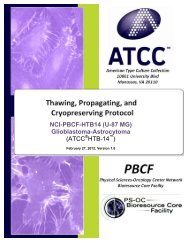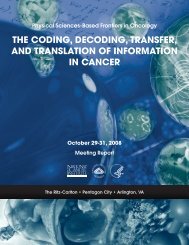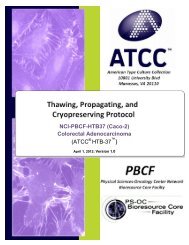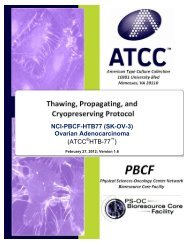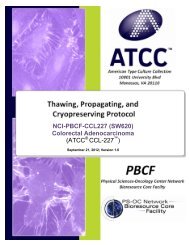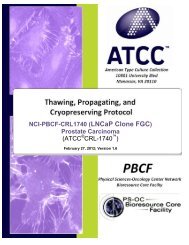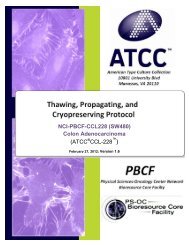ZR-75-1
ZR-75-1
ZR-75-1
You also want an ePaper? Increase the reach of your titles
YUMPU automatically turns print PDFs into web optimized ePapers that Google loves.
SOP: Thawing, Propagation and Cryopreservation of NCI-PBCF-CRL1500<br />
(<strong>ZR</strong>-<strong>75</strong>-1)<br />
Karyotype Summary:<br />
In the karyotype image, arrows indicate regions of abnormality. It should be noted that the<br />
karyotype description includes the observed abnormalities from all examined metaphase<br />
spreads, but due to heterogeneity, not all of the karyotyped cells will contain every<br />
abnormality.<br />
This is a highly rearranged human cell line of female origin containing 69 to <strong>75</strong><br />
chromosomes per metaphase spread (hypertriploid). Structural abnormalities include<br />
rearrangements to chromosomes 6, 8, 9, 10, 11, 14, 15, and 17. There are six<br />
unidentifiable clonal marker chromosomes (markers present in two or more of the examined<br />
cells) [+mar1, +mar2, +mar3x2-3, +mar4, +mar5, +mar6].<br />
The rearrangements include:<br />
Addition of unknown material to the short arms (designated by p) of chromosomes 8<br />
and 17;<br />
Addition of unknown material to the long arm (designated by q) of chromosome 14;<br />
Deletion of material from the short arm of chromosome 6;<br />
Translocations involving chromosomes 10 and 15 [der(10)t(10;15)(q10;q10)], 11 and<br />
17 [der(11)t(11;17)(p15;q11.2)], and chromosomes 11 and 15<br />
[der(15)t(11;15)(q13;p11.2)];<br />
There is an inversion of chromosome 9 involving the chromosomal material between<br />
the short arm at band 13 and the long arm at band 12 [inv(9)(p13q12)].<br />
Numerical changes are based on a triploid karyotype which would contain three copies of<br />
each chromosome (3N). Therefore, karyotype designations such as -21,-22, indicate two<br />
copies each of structurally normal chromosomes 21 and 22. (ISCN 2009: An International<br />
System for Human Cytogenetic Nomenclature (2009), Editors: Lisa G. Shaffer, Marilyn L.<br />
Slovak, Lynda J. Campbell)<br />
Karyotype Procedure:<br />
Cell Harvest: Cells were allowed to grow to 80-90% confluence. Mitotic division was<br />
arrested by treating the cells with KaryoMax® colcemid for 20 minutes to 2 hours at 37°C.<br />
Cells were harvested using 0.05% Trypsin-EDTA, treated with 0.0<strong>75</strong>M KCL hypotonic<br />
solution, and then fixed in three changes of a 3:1 ratio of methanol;glacial acetic acid.<br />
Slide Preparation: Slides were prepared by dropping the cell suspension onto wet glass<br />
slides and allowing them to dry under controlled conditions.<br />
G-banding: Slides were baked one hour at 90°C, trypsinized using 10X trypsin-EDTA,<br />
and then stained with Leishman’s stain.<br />
Page 18 of 24





